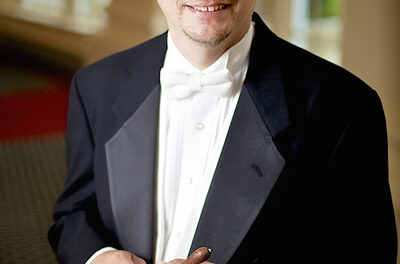Opening a concert with the youthful Felix Mendelssohn and closing with the aging Richard Strauss, the New Century Chamber Orchestra from San Francisco, featuring lead violinist Nadja Salerno-Sonnenberg, lived up to its billing as one of the top small chamber ensembles in the country. Perhaps not as well known yet as another conductor-less ensemble, the Orpheus Chamber Orchestra, this band of 20-plus players delivers a gorgeous string sound, and the four selections on the S. Rudolph Alexander Performing Arts Series program at East Carolina University enabled the players to demonstrate fully their skill and musicianship.
The program opened with a brief string symphony by Mendelssohn, his Sinfonia No. 10 in B minor, played in basically a single movement, though described as having both an adagio and an allegro. The adagio, which starts in a somber mood, is much too short but certainly gives an indication of the kind of melodic compositional skills Mendelssohn would show later in life (this piece was written when he was 14). The “meat” of the composition is the allegro, which includes nice passages for cello and viola and an interesting contrast in syncopated rhythms between the upper and lower strings. The piece builds to a lively and delightful climax. From the outset, the New Century players showed precise attacks, entrances and cutoffs; the forte passages were strong without being harsh, and the softer passages were like velvet.
The featured work on the program was William Bolcom’s Romanza for violin and string orchestra, commissioned by and written for Salerno-Sonnenberg a few years ago. For a 21st century piece, the work is almost listener-friendly, but not quite, at least not until the end. Written in three movements, the piece requires a variety of string-playing techniques by the soloist and the accompanying strings. Salerno-Sonnenberg, who has been with the orchestra since 2008 and is now music director, handled all the demands of the piece with great skill, from the thinnest, quietest solo lines at the beginning to the full-bodied cadenza at the end of the “Valse Funebre” section. The composition includes passages in which the accompanying strings end phrases with an eerie, ghostly sound and sections that recall shape-note singing, except that the passages don’t come to the expected resolution. Only in the final “Cakewalk” section does a more traditional melody line become evident, and this also was quite the jolly portion of the piece, in which Salerno-Sonnenberg and colleagues seemed to have the most fun. In the program notes, Bolcom describes his intent behind the composition as wanting to write a “shamelessly romantic” piece a la Schubert, Schumann or Mendelssohn, but the final product bears scant resemblance to anything by those composers. The final section is quite engaging and received a spirited reading by soloist and orchestra, but getting there was a bit of a struggle for an audience perhaps more accustomed to Schubert, Schumann or Mendelssohn.
Two mid-20th century works brought the program to a close, Bachiana Brasileiras No. 5 by Heitor Villa-Lobos and Metamorphosen by Richard Strauss. The Brazilian work, more often heard as a composition for cellos and soprano or strings and soprano, was arranged for chamber orchestra, with Salerno-Sonnenberg’s violin taking the place of the vocal line. The familiar melody is quite lovely, and the contrast between bowed strings and plucked strings was effective. The first cello had a fine recap of the melody line, played over plucked strings.
Strauss’ Metamorphosen, an elegy mourning the destruction of Germany and Europe in World War II, is an intensely emotional composition to listen to, and it might be equally intense to play. Nearly 30 minutes of uninterrupted melody, colored by the composer’s anguish, this piece harkens back to late 19th century Romantic works. Despite the absence of a single hummable melody, it nevertheless encapsulates much of the best of Strauss’ earlier compositions. What it does is incorporate a variety of sound patterns in which the music is played by the entire ensemble here and a smaller component of the ensemble there and a different smaller component in another section. Only a bit past the midway point does the music seem poised to break into more of a major key hopefulness, but even that does not last long, and the somber feeling of the opening, particularly as expressed in the cellos and double basses, returns. Salereno-Sonnenberg had occasional exposed, though subtle, lines, and the lower strings were especially noteworthy. This is not a piece to seek out for a grand crescendo of a climax; rather, it is a musical memorial, a musical elegy of the first rank. And the New Century Chamber Orchestra gave a terrific performance, one of the first rank.
The orchestra performed two encores and sent the audience out humming — a familiar Brahms Hungarian Dance and even a nice version of “I Left My Heart in San Francisco,” but it was the Strauss piece that resonated.
(A word of advice to Salerno-Sonnenberg: don’t make such a big deal out of folks coming in after the first selection, even in jest. We don’t know the circumstances — car trouble, babysitter trouble, stovetop fire — and you shouldn’t publicly criticize an audience member for quickly finding a seat between the first and second selections. Presumably, that person bought a ticket, which eventually winds up as revenue for you and the orchestra. You are lucky the audience member didn’t reply that he didn’t come to be humiliated and would seek a refund on his ticket.)











